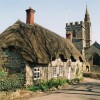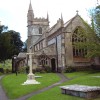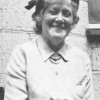“Speak up boy.” The sound of Mr Justice Burrough’s bellowing voice travelled round the Dorchester court room at the Summer Assize court of 1818. The instruction was addressed to the eight year-old boy standing in the witness box. The boy was Charles Brown, a witness for the prosecution at the trial of 28 year-old John Gallop accused of “feloniously, wilfully, and maliciously, and with malice aforethought, assaulting a woman with both his hands at the parish of Bere Regis and by squeezing her throat, mouth and nose, caused a suffocation, whereof she almost instantly expired.” The murdered woman was Priscilla Brown, the boy’s mother; she was killed on the 14th of May 1818. It seems days earlier Priscilla had told John Gallop that she was pregnant with his child.
Charlie, his head, just visible over the witness box, was examined by Mr Banks, counsel for the prosecution. Charlie told the court that he knew the prisoner and had often seen him at his mother’s house. On the Wool Fair Day, Charlie went on, “The prisoner called him out – I was pretty sure it was he by his voice; it sounded from the back door, which leads to the garden.” His mother was at work in the house and there were stones flung three times against the door. Charlie said “my mother went first to the front door then to the back door. Then the prisoner spoke to her; she went out at the back door and went up the garden.”
John Gallop called Thomas Clinch to contradict Charlie’s evidence even though the Judge advised him to consider what he was doing before he called the witness. After Clinch had given evidence Mr Justice Burrough observed that instead of contradicting the evidence of the boy he had confirmed it. Gallop had sealed his own fate.
Several people from Bere Regis were called to give evidence for the prosecution including Thomas Homer, a farmer; John Sexey, Ann Loveridge, Elizabeth Rose and Benjamin Romain with whom John Gallop lodged. Page Ross, a servant, Elizabeth Harris who lived at Affpiddle and Sarah Welch of Bere Regis also testified against Gallop.
Charlie had concluded his evidence saying “She had no bonnet on; she never came back any more. Some time afterwards she was brought home dead.” Gallop was found guilty of murder and hanged.
Eight years earlier his arrival into the world was announced with these words; “16th of December 1810 Charles, bastard son of Priscilla Brown,” They appear in the register of baptisms at the church of St. John Baptist, Bere Regis. Here he spent his life, a life that spanned the allotted three score years and ten and three more, all spent working as an agricultural labourer and bringing up a family.
There was little doubt Priscilla’s boy would be a charge on the parish chest and the Churchwardens and the Overseers to the Poor would have examined Priscilla Brown to establish who Charlie’s father was. On the 15th of June 1811 six months after Charlie’s baptism the Justices made an order against Thomas Welch who they were satisfied was the boy’s father.
Welch was ordered to pay the sum of forty shillings “towards the costs of the lying-in of Priscilla Brown and the maintenance of Charlie to the date of their order.” Additionally, the father was to pay two shillings a week for Charlie’s maintenance.
After the death of his mother he would have had little option but to get on with his life. Any counselling amounting to little more than sympathetic whispering behind his back and this would have quickly evaporated. We don’t know who looked after Charles in the years to adulthood and the events of 1818 were, it seems, quickly forgotten, overtaken by the instinct to survive.
The next milestone in Charlie’s life was his marriage. The church registers inform us that on the 3rd of March 1834 Charles Brown and Elizabeth White were married. According to censuses Elizabeth was born at Bloxworth or Kingston, both places near to Bere Regis. Their marriage was witnessed by George Phillips and Isabella Stickland and sealed a partnership that was to last half a century.
Charles named his first child after his mother. The 1841 census has Charles (30); Priscilla (25); with Elizabeth (7); William (4), and Charles (2). (We have to accept the enumerator switched Priscilla and Elizabeth when listing the family.)
Priscilla earned a living as a button maker and in 1851 she was living in Bere Regis but not with her parents and siblings. By 1861 she was working as a cotton Glover and is back with her family at No.1, Tower Hill, Bere Regis. A search of the records at Bere Regis revealed nothing further about her only that she witnessed the marriage of her brother George Brown in 1865.
Priscilla had three sisters and five brothers. The sisters were Maria born in 1849; Sarah born in 1855 and Charlotte born in 1857. We know that Maria and Sarah died and were laid to rest at Bere Regis on the 7th of October 1855 and the 24th of August 1862. Charlotte moved away. The brothers were William born in 1837; Charles 1840; James 1843; George 1846, and Thomas born in1852.
Elizabeth Brown who survived her husband by 17-years, lived to see the dawning of the 20th century and could look back with some satisfaction over the half century she spent with Charles. Two of their children died in their single years and she out-lived at least one of her grown-up children but for the times this was not unusual. She was blessed with seeing grandchildren married and the arrival of several great grandchildren and it is worth looking back over some of their lives.
Of the boys, William was the first to marry in 1862. Next was Charles in 1863, his bride being Mary Hawkins of Winterbourne Kingston. Charles and Mary had two sons and four daughters. Then on the 15th of March 1865 George married Agnes Cheesman of Winterbourne Kingston. We know from the 1881 census that William married Mary a girl from Wool and in 1881 they were living in Battersea where William was working as an Engine Driver at a factory. Records show they had taken in two lodgers.
In 1871 Charles and Elizabeth were living at 7 West Street, Bere Regis; their daughter Charlotte who was working as a cotton Glover, was with them. Ten years later Charlotte was in Holdenhurst, Hampshire, where she was employed as a domestic servant to a wholesale grocer. Next door at 8 West Street was their son George, his wife Agnes, and their three children: Henry James, Amelia Mary and George – in 1882 another son, Tom, was born.
Of Charles’ grandchildren we know that Sarah Ann, the eldest child of his son Charles, had a child, Alfred Charles, in 1881; he died in 1882. On the 3rd of February 1887 Sarah Ann married John Bright, a widower. Sarah’s grandmother, Elizabeth, signed the register as a witness. John was 12 years-older than Sarah and brought a son and two daughters, all under 10, to the marriage, so Sarah had to adjust in short order to being a wife and a mother. She would have had some experience with children as her siblings were between 10 and 18 years younger than she was. In 1891 John and Sarah Ann had a child they named Edwin John. Over the next decade they had another son Charles and two daughters; Louisa and Florence.
Neither her father nor her grandfather was alive to witness the marriage of Mary Jane Brown, a dressmaker, the daughter of Charles Jnr (he passed away in 1892) to grocer’s assistant Walter Langdown. The ceremony took place at Bere Regis on the 15th of August 1898 and a year later they had a son, Frederick, and early in 1901 a daughter, Mabel.
There can be little doubt Charlie knew who his father was but he chose to be known throughout his life by his mother’s name. He passed away on the 1st of August 1884 aged 73, just five months after celebrating with Elizabeth 50 years of marriage. He died of a diseased heart and his death was registered three days later by his daughter-in-law, Agnes, wife of his son George. Elizabeth, who was known as Betsy, lived for another seventeen years passing away early in 1901 aged 92 years; she spent the last few years of her life living with her son George and his wife Agnes.
His mother’s death is recorded in the registers of the church of St. John Baptist at Bere Regis without mention of how she met her death and whether or not she was with child. The entry reads “Priscilla Brown was buried May 17th 1818, aged 32 years.”



